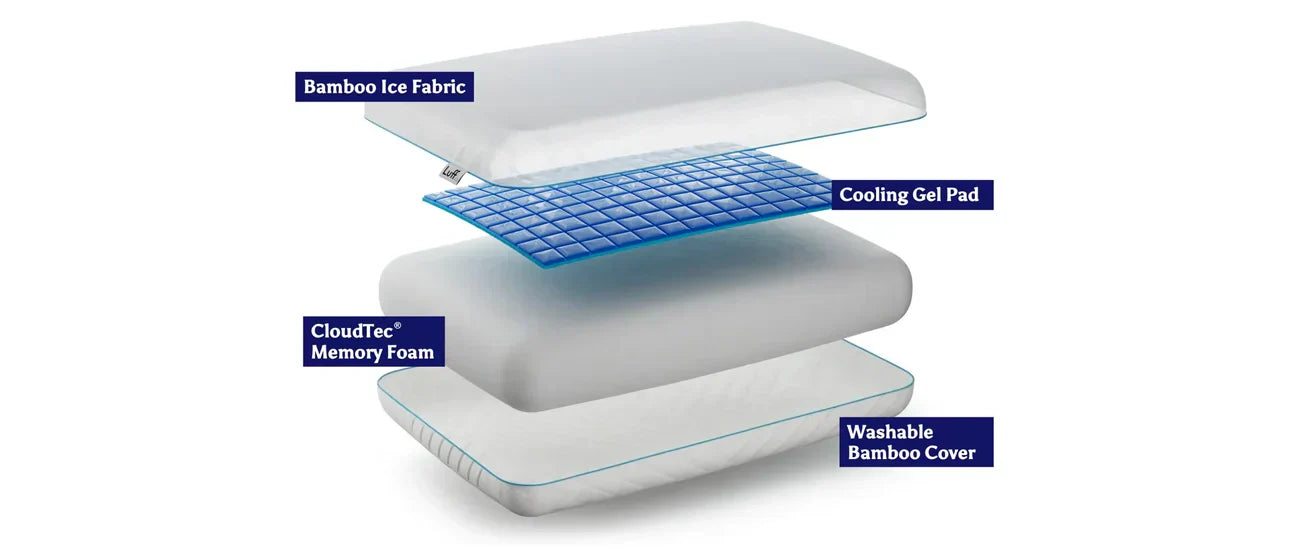Most of us put a lot of thought into our mattress or duvet. But when it comes to pillows, the decision to replace them is often delayed far too long. Over time, even the best pillows wear down, lose support and collect allergens, all of which can affect how well you sleep.
If you have started waking up with a sore neck, headaches or more sneezing than usual, your pillow could be the cause. In this article, we look at how often to replace pillows, how to spot when yours needs replacing and what to look for when choosing the best long-lasting pillows for better sleep.
How Often Should You Replace Pillows?
This is one of the most common questions in any pillow care guide. The answer depends on what your pillow is made of, how you use it and how well you care for it. As a general rule:
- Synthetic pillows should be replaced every 6 to 12 months
- Memory foam and latex pillows normally last 2 to 3 years, but blends like CloudTec last 3 - 10 years.
Pillows lose their shape, support and hygiene over time. Dust mites, bacteria and moisture build up, especially if you sweat at night or sleep without a pillow protector. Even if a pillow still feels soft, it may not be supporting your neck or spine the way it once did.
Why Pillow Lifespan Matters for Sleep Quality
When a pillow starts to degrade, it can cause more harm than many people realise. A worn-out pillow often leads to:
- Poor spinal alignment
- Increased neck and shoulder tension
- Reduced airflow, making it harder to stay cool
- A build-up of allergens that can trigger irritation
These issues develop slowly, which makes them easy to ignore. But over time, they affect how deeply and comfortably you sleep.
Swapping your pillow out at the right time can help improve posture, reduce aches and improve overall sleep quality without changing anything else in your routine.
How to Know When to Replace Your Pillow
Not sure if your pillow has reached the end of its life? Here are some common signs to watch for:
- The pillow has become flat or lumpy
- You often wake up with a stiff neck or headaches
- You sleep better with a hotel pillow than your own
- The pillow has a musty smell or visible discolouration
- You fold the pillow in half and it doesn’t spring back
If one or more of these apply, it’s probably time for a replacement. Understanding how often to replace pillows can help you maintain both comfort and hygiene throughout the year.
Choosing the Best Long-Lasting Pillows for Regular Replacement
The key to avoiding frequent replacements is choosing a pillow made from durable, supportive materials. Memory foam pillows tend to last longer and hold their shape better than basic synthetic options.
At Luff Sleep, we design our pillows with both comfort and longevity in mind. The Prestige Adjustable Bamboo Pillow is filled with shredded memory foam and bamboo fibre, offering the structure and breathability needed to stay supportive for 10 years. It can also be adjusted to match your preferred height and firmness, helping you maintain good sleep posture over time.
The Mayfair Cooling Pillow is a firmer option with a cooling gel layer and memory foam core. Its dense design helps it retain shape and support for longer, while the breathable cover helps reduce moisture build-up and heat retention, two factors that shorten pillow lifespan.
Both options are designed to provide excellent support, while resisting flattening, sagging and odour over time.
Pillow Care Guide: How to Make Your Pillow Last Longer
While even the best pillows need replacing eventually, proper care can extend their life and keep them fresher for longer. Here are a few tips from our own pillow care guide:
- Use a pillow protector to shield against sweat, skin oils and dust
- Wash your pillowcase weekly, especially if you have allergies or sensitive skin
- Fluff or reshape your pillow every few days to maintain structure
- Avoid folding, leaning against or squashing memory foam
- Let it air out by removing the case during the day, especially in humid rooms
Following these tips can help extend the lifespan of your pillow by several months, even years, depending on how frequently you use it.
When in Doubt, Refresh Your Setup
Sometimes, pillow wear is gradual and hard to notice until you try a new one. Many customers tell us they had no idea how much better they could sleep until they upgraded.
That is why we recommend checking your pillow once or twice a year. Lay it on a flat surface, test for rebound, and see how it feels after a full night’s sleep. If you are waking up with aches or struggling to get comfortable, it might not be your mattress. It could simply be your pillow.
Better Sleep Starts with the Right Support
Pillows are not just accessories. They are a vital part of your sleep posture, breathing and comfort. Replacing them regularly helps ensure you are getting the full support you need to rest properly.
If you are ready to upgrade, our range of Luff Sleep pillows is crafted to provide the right balance of comfort, support and longevity. Whether you want adjustable fill, cooling layers or firm contouring support, we have something to match your sleep style.
For a full upgrade, consider pairing your new pillow with our 100% Organic Bamboo Bedding Set. Breathable and naturally soft, it helps support deeper, more comfortable sleep, night after night.
Final Thoughts
Knowing how often to replace pillows is one of the easiest ways to improve your sleep setup. Old pillows not only lose support but can also impact hygiene and comfort in ways that creep up gradually.
By checking your pillow regularly, following simple care routines and choosing the best long-lasting pillows, you can improve sleep quality and reduce unnecessary discomfort.
If you are unsure whether your current pillow is holding you back, trust how your body feels when you wake up. A new pillow could be the easiest way to sleep better, sooner.






